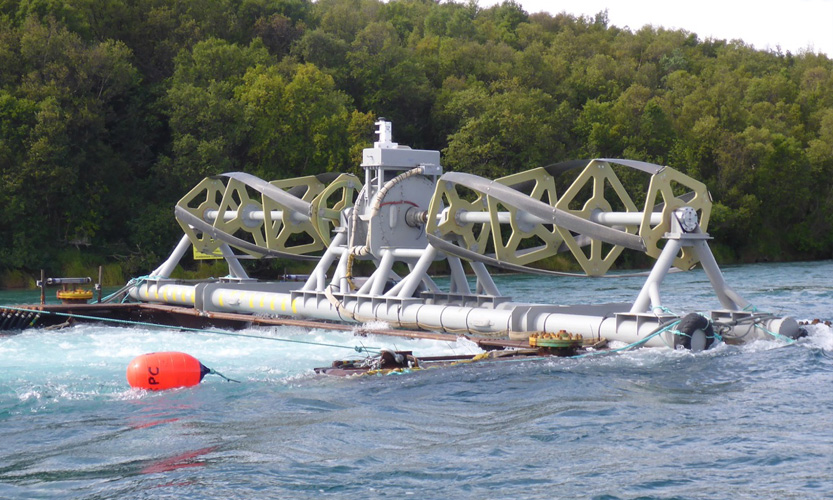Here's a look at some of the next-generation energy under development:
![Tidal energy project [image : 78289396]](http://www.gannett-cdn.com/-mm-/c95501485c57f1cd2b5b2d90e25e945152265bc9/c=124-0-709-500/local/-/media/2016/01/04/IAGroup/DesMoines/635875447379219198-Igiugig-RivGen-kvichak-2015522227.jpg)
Tidal power
Some companies are developing technology that would enable Americans to tap into energy derived from ocean waves and river tides, according to the U.S. Department of Energy. One company is using this hydrokinetic technology on an Alaskan river to provide electricity to a remote village. The project seeks to decrease the community's diesel fuel use and help lower electricity costs. All the small rural village's fuel is either shipped or flown in.
![Changing carbon dioxide from problem to fuel [video : 78504182]](http://bcdownload.gannett.edgesuite.net/desmoines/35546125001/201601/1494/35546125001_4686837703001_video-still-for-video-4686733493001.jpg?pubId=35546125001)
Pyrolysis
Scientists and engineers at universities and startups are exploring ways to create carbon-negative energy. One approach is pyrolysis, a technology that rapidly heats biomass, such as corn stalks, switchgrass or wood chips, without oxygen to produce a bio-crude that can be used for transportation fuels or bio-based chemicals or to generate electricity. It also produces biochar, a carbon-rich solid similar to charcoal produced in campfires, that can be applied to farmland to sequester carbon and boost soil fertility.
![isu-pyrolysis.jpg [image : 78290144]](http://www.gannett-cdn.com/-mm-/39e755853bf1f4357f73184a6dd60d58271b2509/c=181-0-1000-700/local/-/media/2016/01/04/IAGroup/DesMoines/635875460213430005-isu-pyrolysis.jpg)
Capturing carbon
Startups and scientists like Klaus Lackner at Arizona State University are working to capture carbon dioxide from the air. Some startups use liquids to help capture carbon. Other research uses materials that absorb carbon then release it when it gets wet. Researchers hope to reuse the carbon, potentially as an ultra low-carbon fuel.
Solar fuel
Researchers at the California Institute of Technology and elsewhere are working to create energy from sunlight, water and carbon dioxide. At Caltech's Joint Center for Artificial Photosynthesis, scientists are using sunlight to create a synthetic fuel that can be used in cars, trucks and other vehicles. "Instead of making starches and sugars that provide sustenance to plants, we're interested in producing transportation fuels ... that are drop-in replacements for the fuels we use now," said Harry Atwater, the center's director. "Instead of CO2 being an ever-increasing scourge as a greenhouse gas, we'd like it to become a renewable resource — something we can recycle."
Advanced nuclear energy
Several scientists seek to turn nuclear waste into a new generation of energy. The idea is to reprocess the used fuel — only a fraction of the energy has actually been spent — to create low-carbon electricity. With about 270,000 metric tons of nuclear waste globally, it would generate enough energy to power the world for about 60 years, even with growing energy needs, scientists estimate. The advanced nuclear technologies being explored are safer than traditional nuclear energy plants and help solve vexing concerns about storing spent waste, advocates say. Critics, though, say reusing the waste could make it more available to enemy nations and terrorists who seek to develop nuclear weapons.
High-altitude wind mills
Several startups are investigating approaches to tapping wind energy at high altitudes. Altaeros Energies, for example, is building wind turbines inside helium gas-filled industrial blimps that are tethered to the ground to generate electricity. At 2,000 feet in the sky, the company says a turbine will generate twice as much energy as conventional turbines. Iowa State University engineers are working on taller wind towers made from strengthened concrete that would stand at least 330 feet in the air, about 130 feet taller than today's towers.
![Tall-wind-mills.jpg [image : 78319728]](http://www.gannett-cdn.com/-mm-/865badb154e068d7c4c238beab69d76da1b21770/c=416-0-3280-2448/local/-/media/2016/01/05/IAGroup/DesMoines/635876082386315429-Tall-wind-mills.jpg)


